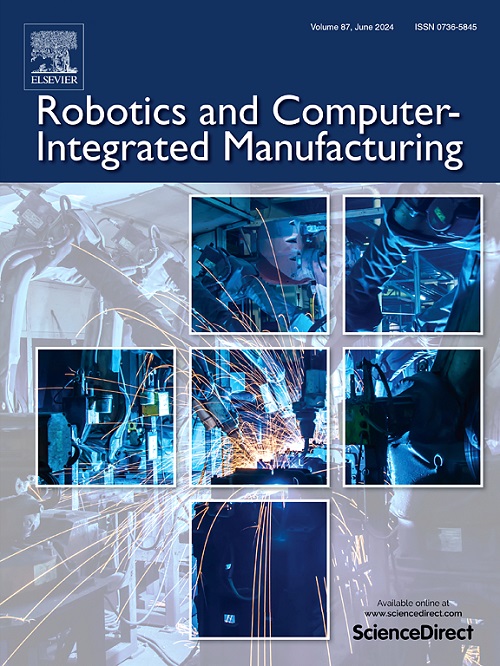Enhancing industrial human action recognition framework integrating skeleton data acquisition, data repair and optimized graph convolutional networks
IF 11.4
1区 计算机科学
Q1 COMPUTER SCIENCE, INTERDISCIPLINARY APPLICATIONS
引用次数: 0
Abstract
The precise interpretation of human actions is crucial for seamless interaction and operational efficiency for industrial human-robot collaboration. However, existing skeleton-based action recognition methods focus on algorithmic applications while overlooking key challenges such as robust data acquisition, validation, and repair. Additionally, the scarcity of high-quality industrial datasets and the challenges in distinguishing similar actions further limit the capability to infer operators' intentions accurately. This paper presents a novel framework to address challenges utilizing integrating skeleton data acquisition, effective data augmentation method, and an optimized graph convolutional network. Specifically, the proposed framework employs a pose estimation method for 2D (two-dimensional) joint estimation and a 2D-to-3D (three-dimensional) lifting technique, supplemented with a robust method for repairing invalid skeleton data and a skeletal feature-based data augmentation strategy. To enhance action recognition, this paper introduces the Channel-Topology Refinement Graph Convolutional Network Plus (CTR-GCN-Plus), which incorporates dynamic topology learning and multi-channel feature aggregation, augmented with hand motion integration for finer differentiation of similar actions. The proposed framework is evaluated on an industrial assembly dataset incorporating challenging scenarios, such as occlusions and similar actions. Experimental results demonstrate that the proposed methods significantly improve accuracy, enhance recognition of similar actions, and effectively account for individual variations, outperforming existing approaches in industrial human-robot collaboration environments.
集成骨架数据采集、数据修复和优化图卷积网络的工业人体动作识别框架
人类行为的精确解释对于工业人机协作的无缝交互和操作效率至关重要。然而,现有的基于骨架的动作识别方法侧重于算法应用,而忽略了关键挑战,如稳健的数据采集、验证和修复。此外,高质量工业数据集的稀缺以及区分类似行为的挑战进一步限制了准确推断操作员意图的能力。本文提出了一个新的框架,利用集成的骨架数据采集,有效的数据增强方法和优化的图卷积网络来解决挑战。具体而言,该框架采用了一种用于2D(二维)关节估计的姿态估计方法和一种2D到3d(三维)提升技术,并辅以一种用于修复无效骨骼数据的鲁棒方法和一种基于骨骼特征的数据增强策略。为了增强动作识别,本文引入了通道拓扑优化图卷积网络(ctrn -Plus),该网络结合了动态拓扑学习和多通道特征聚合,并增强了手部运动集成以更好地区分相似动作。提出的框架在工业装配数据集上进行评估,该数据集包含具有挑战性的场景,如遮挡和类似的动作。实验结果表明,本文提出的方法显著提高了准确率,增强了对相似动作的识别,并有效地考虑了个体差异,在工业人机协作环境中优于现有方法。
本文章由计算机程序翻译,如有差异,请以英文原文为准。
求助全文
约1分钟内获得全文
求助全文
来源期刊
CiteScore
24.10
自引率
13.50%
发文量
160
审稿时长
50 days
期刊介绍:
The journal, Robotics and Computer-Integrated Manufacturing, focuses on sharing research applications that contribute to the development of new or enhanced robotics, manufacturing technologies, and innovative manufacturing strategies that are relevant to industry. Papers that combine theory and experimental validation are preferred, while review papers on current robotics and manufacturing issues are also considered. However, papers on traditional machining processes, modeling and simulation, supply chain management, and resource optimization are generally not within the scope of the journal, as there are more appropriate journals for these topics. Similarly, papers that are overly theoretical or mathematical will be directed to other suitable journals. The journal welcomes original papers in areas such as industrial robotics, human-robot collaboration in manufacturing, cloud-based manufacturing, cyber-physical production systems, big data analytics in manufacturing, smart mechatronics, machine learning, adaptive and sustainable manufacturing, and other fields involving unique manufacturing technologies.

 求助内容:
求助内容: 应助结果提醒方式:
应助结果提醒方式:


